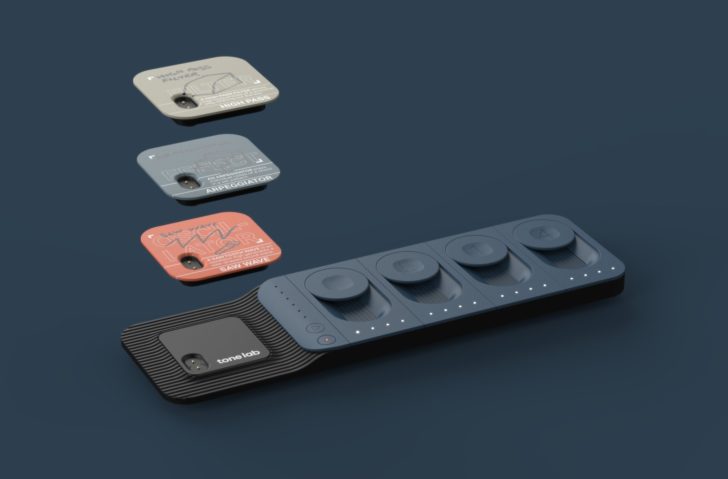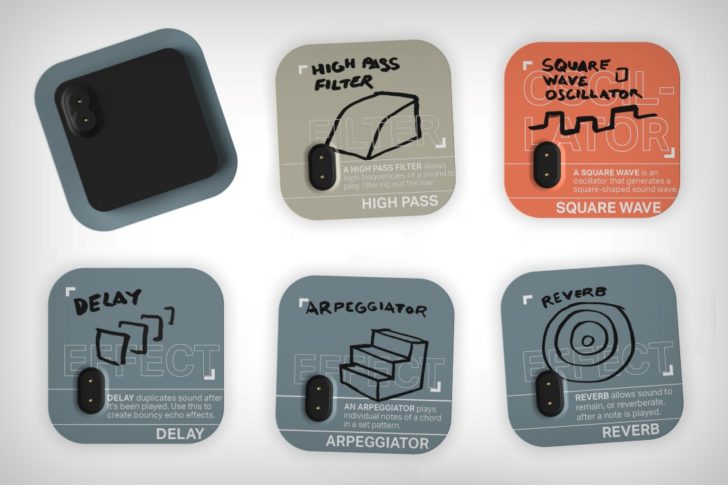Tone Lab is a design concept, created by industrial designer Colin Hearon, for a new type of synthesizer.
Tone Lab is designed to be hands-on and tactile like a modular synth, but drastically simplified, to make it much more user-friendly. Patches are created by stacking elements of a sound. Stacking allows users to physically build layers of sounds, just as layers of effects are built up in software applications.
Here’s the official intro video:
Summary:
Tone Lab is a musical synthesizer kit that upends the traditional software-based approach to digital music production techniques.
Currently, music making software is structured in a very technical manner not conducive to learning. Complicated menus, idiosyncratic functions, and highly technical options are incredibly prohibitive to young, new artists.
Tone Lab is restructured to be playful and informative, teaching the basic tools of digital music production by making them into physical building blocks that users can stack up, hearing how the effects interact with one another in real time. The pieces each have graphical elements that teach real industry terms so that users can acquire useful and relevant knowledge.This service allows new users to access the creative world of digital music making, broadening creative diversity in the field.
See Hearon’s site for more details.
via Yanko Design




The “Ladies!” are really into music these days. I think its a good thing but I’d rather see them making music than solely being models in an ad. They make it seem like this will be a great alternative to a full production system and that garage band won’t allow users to learn the technical skills of a complete system of DAW. But this is less than garage band so im not sure what they are trying to do there besides looking like a product design master class with a pretty cool trailer to promote the product.
I don’t understand the confusion. They don’t say you can’t learn garage band; they say it’s hard and time consuming which defers the point at which you can use the tool creatively. I did not get the sense they were saying it’s a replacement for a DAW at all. It’s just supposed to be an intuitive way to experiment with different components of synthesis so you can learn while also producing something that is satisfying — avoid overwhelming UIs or underwhelming static sonic palettes. I doubt they really see it as something to produce hits, just to make it reward your ears as you learn. Another take on the “legos of synthesis”.
Very clever concept, great for synth newbies…
Not sure what this is going to teach you that a soft synth on your phone or cheap mono synth couldn’t. Plus they’d be a lot more playable. Cool hardware controller – I assume it’s all a soft synth internally. Polyphony? Hook up a MIDI keyboard? Drum sounds? …
Looking at the website is useful to understand the context as a design exercise rather than a commercial product.
Coming next, the lego synthesizer.
There already exists several variations on a building block concept.
Nothing wrong with that. We all have different preferences.
It ignores the contradiction that if you’re not motivated to learn apps, garageband, etc, how will you ever be motivated to pay the disproportionately large amount that this will inevitably cost if it ever were a product?
For those people that have much more money than patience, sure. But there’s very few of them.
And that’s putting aside if even then it actually is useful by itself for making music. It looks like you’ll need 2-3 of these for any interesting full song to begin emerging. And how do you then change anything? I.e., alter the reverb, change a chord… No, I’ll put this in the pile with all the other design exercises and kickstarters, like that electronic codpiece from 2 years back…
And all the other instruments that assume that people do not like to challenge themselves when learning something new… When in fact, at least to me, that is the very thing that makes us human!
So yes, they physical execution may be very attractive, but I see little thought behind it beyond that.
i can see how you set up one sound. but i can’t see how you can compose a track the complexity of which they used for their outdo. seems very misleading and potentially very “gotta catch em all” if you have to buy physical cards for each oscillator, effect, etc…like paying money for each menu option in reaper… which is free…
Creative as a concept, yes. Useful or universal, no. Takes something which isn’t obvious to the regular person and makes it more abstract and removed from actual application/usage.
Also, lol at them using Reason as an example of complexity on their site. (I agree, it’s not intuitive.) But maybe they should learn/teach Ableton or GarageBand.
Nonsense. You can learn any synth or software step-by-step and be creative while doing it. The learning process is what makes things fun and rewarding. Instant gratification makes it just another toy to toss aside when the next one comes along.
How easy is it for blind people to use. It a very interesting concept. One poster said there variation which is good news.
So there will come more modules over time? How many om them are you able to stack before it’s getting unstable?